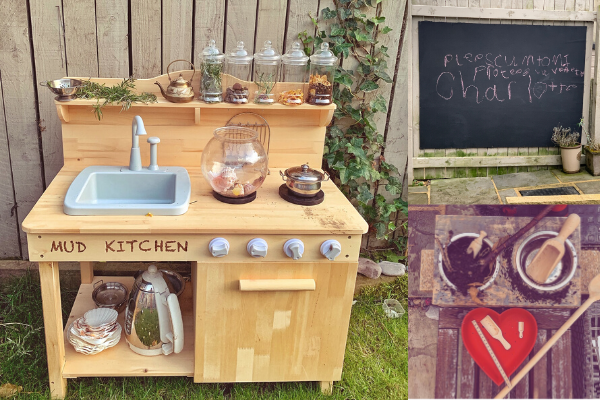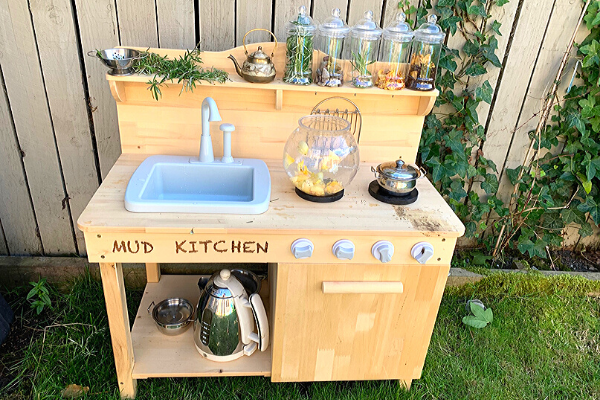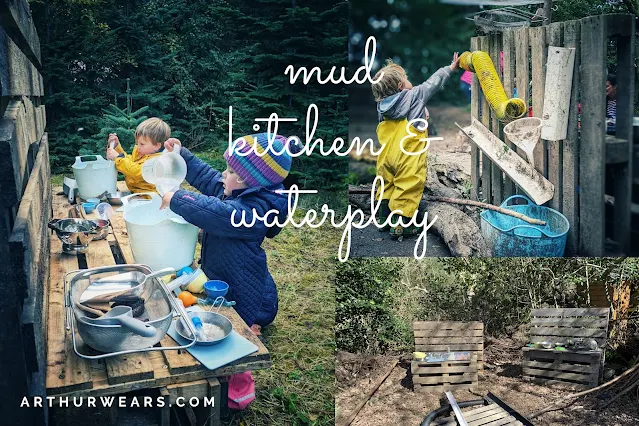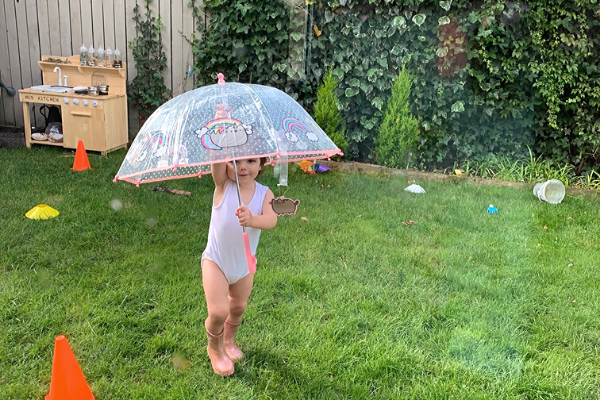Would you like to understand more about what a mud kitchen is? What the benefits are of having a mud kitchen in your outdoor area? How can you you effectively use a mud kitchen and plan for activities for kids? What do you need in a mud kitchen? Where can you buy a mud kitchen and accessories and what are the learning outcomes?
This post aims to give some useful ideas and inspiration for using your mud kitchen and mud kitchen accessories effectively for outdoor play...
For young children to really benefit from outdoor play, the outdoor area should be an extension of the indoor area - not a simply a separate place for 'limited' playtime, a reward for hard work or somewhere to simply 'have a run around'. I have talked before about this separation of indoor and outdoor play, and the negative consequences that this can have in my post about the importance of learning through play outside which can be found here. One of the key pieces of equipment for an outdoor learning space, which will tie into lots of different areas of learning is to have a mud kitchen. Whether you are looking to encourage role play, speaking and listening, relationship building, mathematical concepts or simply to create a space where children can learn and explore and play with what they know or just make mud pies - a mud kitchen provides endless possibilities...
Mud Kitchen | Ideas & Accessories
Would you like to buy this mud kitchen and accessories?
Other Mud Kitchen Resources: UK List / USA List
* Contains Affiliate links - purchasing through these links will not cost you anymore, but I may earn commission on qualifying purchases
What is a Mud Kitchen?
A mud kitchen is an area, either purpose built or fashioned out of natural / recycled materials, where children are able to take on a role, use their imaginations and engage in meaningful, sensory play - either alone or alongside others. The key ingredient is of course mud, but can also include other foraged and found natural resources such as sticks, gravel, stones, herbs, flowers, plants and weeds. Containers are an important accessory resource for a mud kitchen, so that children are able to mix their 'ingredients' and try out their concoctions, as is the addition of water... if nothing else, a bucket or a bowl, pans, some sticks and some mud are all you really need to get going, the rest is down to your imagination!
 |
| Photo credit - D Wicks, FB group member |
Why have a Mud Kitchen- What are the benefits?
Resources which help to promote imaginative play are beneficial for children of all ages. Role play is such a valuable learning experience - it can be used to introduce so many learning opportunities in a fun and meaningful way - the key is how you extend the learning by provocations, modelling and questioning, depending on what your focus is.
Aside from the opportunity to learn lots of concepts through play, it is widely believed that it is beneficial for children to play outdoors amongst mud and soil in order to build their immune systems (mud pie anyone?). Outdoor play has positive benefits to mental health and well-being, helps to increase a natural exposure to vitamin D, fresh air, exercise and the ability to work alongside and engage with others during play.
Where to buy a Mud Kitchen?
There are many options for buying or building and making your own DIY mud kitchen. Palettes and recycled / reclaimed materials can be used to make/ DIY your own or you can buy pre-made mud kitchens, purpose built resources or clever resources hacks online and in store. Here are a few of my favourites:
How to make a mud kitchen:
Using mini pet bowls such as these is great way of creating a mini mud kitchen on a budget, or within a smaller area, and of course, they can be moved around or put away easily if needed.
You can also make your own DIY mud kitchen using palettes as you can see in the images below from Wirral Wildlings Forest school - this essentially gives you the permanent base structure and then you can add in your mud kitchen accessories...
Buying a mud kitchen:
Mud kitchen with pump action water tap:
This mud kitchen from Studio has a working tap with a pump action - the water is contained underneath the top layer tap and is reused once the water goes down the sink hole and into the container underneath, ready to be pumped back out. The sink can be removed for ease of cleaning, or, just to use on its own such as here:
For more online mud kitchens and resources, you can view my mud kitchen list here:
Where to put a Mud Kitchen?
If you are choosing a place for your mud kitchen at home or within a setting, finding a little cosy corner, or wall space will help to keep this separate from other areas which may be utilised outside. Make sure there is a good supply of mud, soil and water. Having natural resources growing nearby which the children are able to forage would be a good idea, as well as extra space for mixing and mudpie making!
If possible, try to include a mark making area closeby, so that the children are able to write menus, take orders or make signs or recipes for their mud kitchen:
If you are worried about your mud kitchen and resources being damaged by the elements, consider placing it under a canopy or a purpose built den.
If you have the space, creating a seating area close by to your mud kitchen will allow for kids to have greater interactions and roleplay with peers.
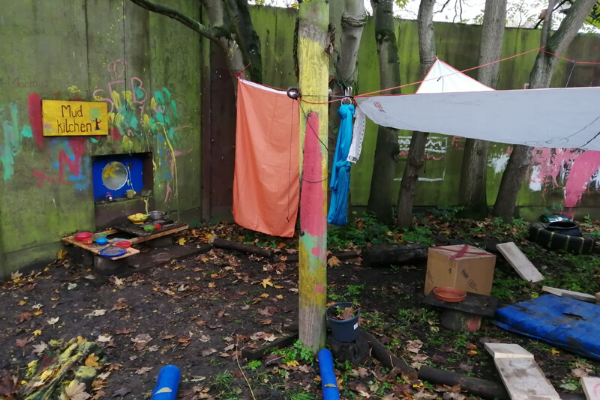 |
| Photo credit - D Wicks, FB group member |
Perhaps your mud kitchen is part of your Forest School, or maybe you'd like to set up a forest school at home? If so, have a read of my post on Forest School Activities for lots of ideas for outdoor learning.
What to put in a Mud Kitchen?
Aside from any natural materials you can make use of from your outside area, the following list includes some ideas for resourcing your mud kitchen:
Accessories for a mud kitchen:
Here is a list of equipment and accessories for your mud kitchen to get you started:
- stones and pebbles
- sticks and log slices
- herbs and spices
- dried flowers and petals
- stainless steel and wooden utensils such as spoons, whisks, cutlery etc
- weighing scales
- Scoops and measures
- recipe cards
- recipe books
- dried fruit
- shells
- thrifted teapots, jugs and other containers
- bowls and cups
- mark making materials
- pots and pans
- Wildflower playdough
- Felt balls - you can buy felt balls here
 |
| gluten free wildflower playdough from childledplay.co.uk |
How to use a Mud Kitchen?
Using a child-led approach is best when it comes to role play, by placing carefully selected resources in your mud kitchen for children to use, you will then be able to observe and notice language and learning which will help you to plan for and work on their 'next steps' by immersing yourself within their play and introducing key concepts and ideas in a playful yet meaningful way...
There is a wonderful mud kitchen book available here by Sophie Pickles which contains lots of fab outdoor ideas for mud kitchen play...
Mud Kitchen Activity ideas and lesson plan ideas:
- Making potions
- making natural piant
- making mudpies
- Role Playing a Cafe
- Rock painting play food
- Developing language through commenting and questioning
- noticing differences and changes when mixing and making
- ordering food by size an weight
- weighing and measuring
- writing recipes
- following recipe instructions
- sequencing recipes
- making menus
- Labelling resources
- learning about one more and one less in relation to ingredients
- mathematical concepts through time and number counting
- Addition through finding a total when serving customers
- counting out when serving customers
- Halving and doubling
- Learning about health and safety and self care
- fine and gross motor skills when using resources and equipment
- Making homemade playdough
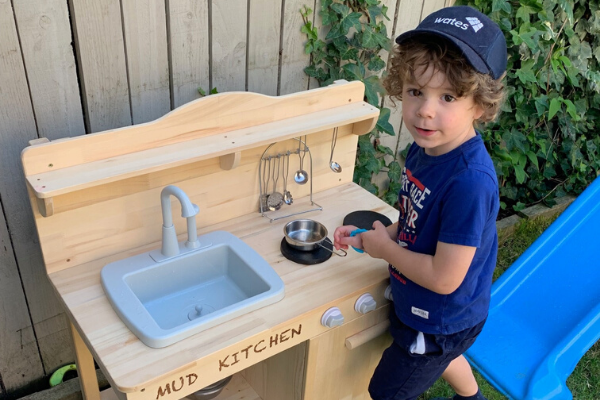 |
| Arthur pretending he was working at McDonalds |
How do you waterproof a mud kitchen?
Even pre-made mud kitchens will need re-treating eventually, to keep them in good condition and to stop those pesky wasps stripping the wood! I have a very satisfying video over on instagram here showing how I cleaned up and then treated our mudkitchen. After washing and and sanding down our mudkitchen, I put a wax treatment on the wood and then sealed the entire thing with yacht varnish. I used a spray can for ease, but next time I will use a paint on yacht varnish to waterproof and protect the wood as the spray didn't give a durable enough finish. You can also use paint especially for outdoor furniture - I can highly recommend the Frenchic Al Fresco outdoor paint range for painting your mud kitchen or garden furniture...I haven't yet decided on the colour I want for this project, but I have used their paints for other projects.
Mud Kitchen Learning Outcomes:
Mud Kitchen play will focus on the following Learning Areas:
(obviously other Learning areas will also be appropriate depending on how you extend the activity or use effective questioning)
Characteristics of effective learning:
Finding out and exploring:
•Showing curiosity about objects, events and people
•Using senses to explore the world around them
•Engaging in open-ended activity
•Showing particular interests
Playing with what they know:
•Pretending objects are things from their experience
•Representing their experiences in play
•Taking on a role in their play
•Acting out experiences with other people
Personal, Social and Emotional Development: Making relationships
•Interested in others’ play and starting to join in.
•Seeks out others to share experiences.
•Can play in a group, extending and elaborating play ideas, e.g. building up a role-play activity with other children.
• Initiates play, offering cues to peers to join them.
•Keeps play going by responding to what others are saying or doing.
•Demonstrates friendly behaviour, initiating conversations and forming good relationships with peers and familiar adults.
Expressive Arts and Design: Being imaginative
• Initiates play, offering cues to peers to join them.
•Keeps play going by responding to what others are saying or doing.
•Demonstrates friendly behaviour, initiating conversations and forming good relationships with peers and familiar adults.
Expressive Arts and Design: Being imaginative
•Engages in imaginative role-play based on own first-hand experiences.
•Builds stories around toys, e.g. farm animals needing rescue from an armchair ‘cliff’.
• Introduces a storyline or narrative into their play.
•Plays alongside other children who are engaged in the same theme.
•Plays cooperatively as part of a group to develop and act out a narrative
Communication and Language: Speaking
•Builds stories around toys, e.g. farm animals needing rescue from an armchair ‘cliff’.
• Introduces a storyline or narrative into their play.
•Plays alongside other children who are engaged in the same theme.
•Plays cooperatively as part of a group to develop and act out a narrative
Communication and Language: Speaking
•Beginning to use more complex sentences to link thoughts (e.g. using and, because).
•Uses talk in pretending that objects stand for something else in play, e,g, ‘This box is my castle.’
•Uses language to imagine and recreate roles and experiences in play situations.
Introduces a storyline or narrative into their play.
Mathematics: Numbers:
•Uses some language of quantities, such as ‘more’ and ‘a lot’
• In practical activities and discussion, beginning to use the vocabulary involved in adding and subtracting.
solve problems, including doubling, halving and sharing.
Understanding the world:
•Comments and asks questions about aspects of their familiar world such as the place where they live or the natural world.
•Can talk about some of the things they have observed such as plants, animals, natural and found objects.
Would you like to see how we set up our learning inside? My post on our child led playroom here, and this Ikea Flisat desk hack should give you some good ideas for indoor learning.
Don't forget, all of our tuff tray ideas for open ended play can also be used in the outside area.
If you would like to know why children in year 1 and key stage 1 should still have access to a mud kitchen and play based learning, have a read of my post - should year 1 children still have continuous provision.

